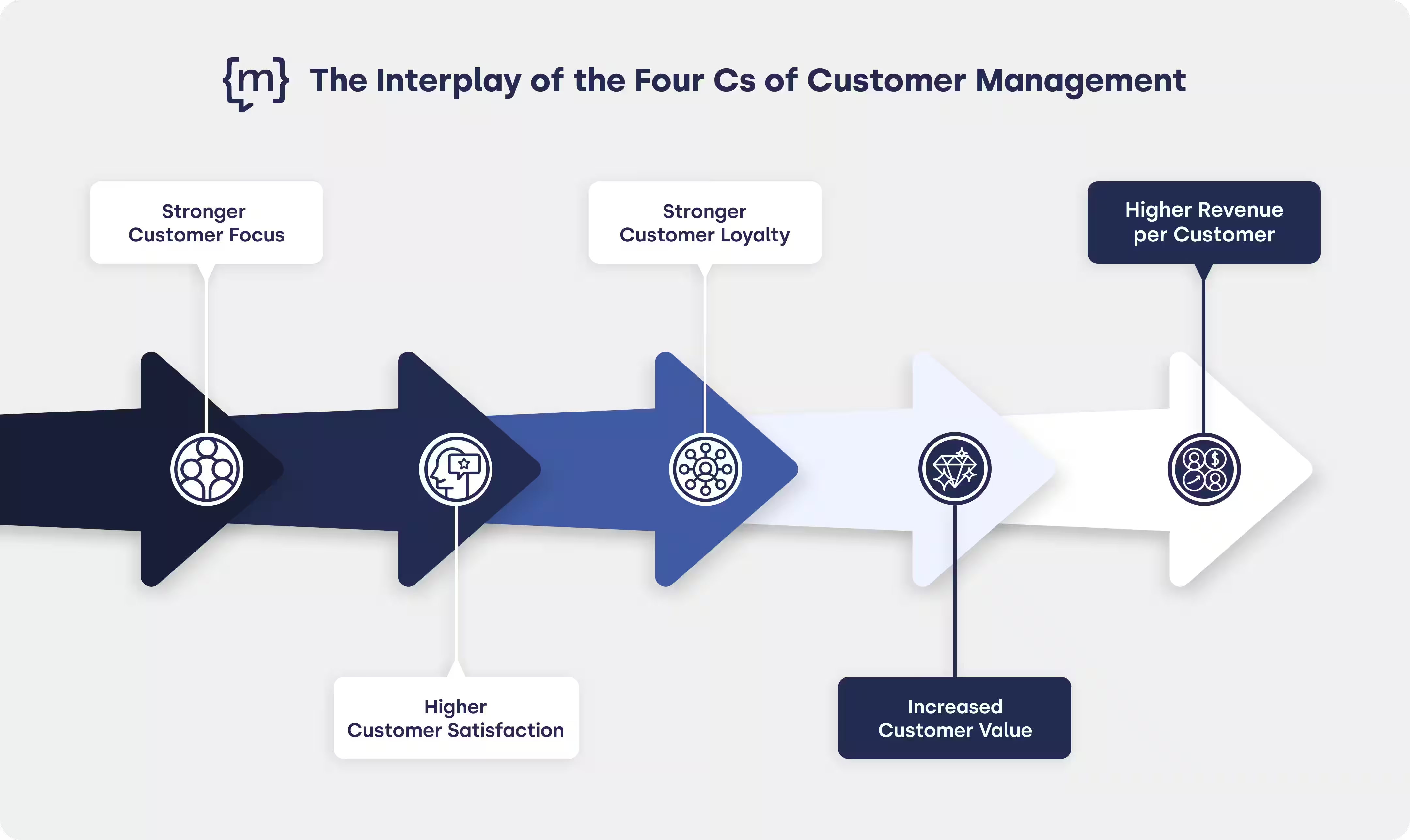Definition: What is Customer Management?
What exactly is customer management? Customer management encompasses targeted measures within a company that are designed to increase customer satisfaction and loyalty. The main goal of customer management is to ensure sustainable business growth.
To this end, this approach aligns important processes and decisions within the company with customers and their needs. To ensure that this works holistically, customer management should be the responsibility of various departments, e.g. sales, customer service or marketing.
What are the tasks involved in Customer Management?
Since customer management is a very comprehensive responsibility, it is often divided into different sub-areas that have specific tasks and objectives. This is also referred to as the ‘4Cs’ of customer management.
1. Customer Orientation
An important component of customer management is customer orientation. ‘What are our customers' wishes and needs, and how can we fulfill them?’ This is the central question that must be asked if you want to be customer-oriented. Companies should therefore analyse their target groups and their needs in detail and align their products or services, activities and processes accordingly.
2. Customer Satisfaction
Customer satisfaction is also about customer wishes and expectations. Whether buyers are satisfied depends on the extent to which their expectations of a company and its products are met. If you want to increase customer satisfaction as part of customer management, you must meet or even exceed these requirements. To do this, companies must take a close look at their different customer groups, analyse their expectations and, for example, use surveys to determine how satisfied they are.
3. Customer Loyalty
PA key task in customer management is to retain customers through specific measures. In the best case scenario, they become long-term regular customers or fans of the brand who buy the products regularly and also recommend them to others. Customer loyalty is an important issue because it is many times more expensive to attract new customers than to retain existing ones.
4. Customer Value
Not every customer has the same value for companies. Customer value depends on how often and how much the buyer purchases. However, the effort required to acquire or serve this customer also plays a role. The goal is to have as many customers with high customer value as possible. In customer management, it is important for companies to know their customer values and to group their buyers according to these values. This enables them to implement targeted measures for different groups. For example, they should invest particularly in customer loyalty measures for buyers with high customer value. One key figure that expresses customer value is customer lifetime value.
It is important that companies promote all ‘4Cs’ equally in customer management. Why? Because they are interdependent:

Customer management also encompasses the following specific areas of responsibility, which tie in with the 4Cs:

Why Customer Management matters
The many positive effects of good customer management demonstrate how important this approach is:
More Effective Measures: Customer management elevates customer loyalty activities to a strategic level and structures them. This ensures that customer-oriented measures within the company are coordinated and therefore more effective.
Higher Customer Satisfaction: Strategic customer management helps to close the gap between customer expectations and reality. And that increases customer satisfaction.
Increased Customer Lifetime Value: More satisfied customers are also more likely to remain loyal to a company – this means that more revenue can be generated with them without incurring costs in the service area due to complaints or claims, for example. Customer value therefore increases.
Higher Revenue: The effectiveness of the 4K shows that customer management also pays off financially. Companies that build close relationships with their customers are more likely to achieve better financial results.
Cost Savings: As already mentioned, it is up to three times more expensive to acquire new customers than to retain existing ones. Good customer management can therefore save a lot of costs, for example in marketing, by retaining customers. And this minimizes administrative effort in customer relationship management, for example, because important information such as contact details, product preferences and interests are already available for existing customers. With new customers, this information must first be requested and analyzed.
Competitive Factor: At a time when consumers can choose from a seemingly endless selection of brands and products online, a company cannot afford not to be customer-oriented. Good customer management is therefore a significant competitive advantage for companies that want to be successful in the market.
Customer Management Software
For customer management to be successful, it is essential to have a centralised collection of all important customer data. Contact details, order histories, contact points, purchasing habits – all of this should be available to all departments that have contact with customers. This works best with customer relationship management (CRM) tools or software.
CRM software helps to implement customer management efficiently. How? It provides a comprehensive view of the customer with consistent and up-to-date information. Departments such as marketing, sales and customer service can thus coordinate their activities. This prevents, for example, customers from being approached twice by different teams.
However, the functions of modern CRM systems go beyond those of a pure database and now automate many processes. The functionalities include, for example:
- Segmentation and analysis of customer groups
- Lead management
- Campaign management and analysis
- Automated communications such as personalised offers, individual messages to customers, reminders and much more.
They cover the entire ‘life cycle’ of a customer. CRM systems therefore help to take customer management to the next level.
How Chatbots can support Customer Management
Today's innovative developments in the chatbot landscape make them a valuable tool for leveling up the Customer Management. AI Chatbots can also be described as the next generation of CRM. They are in one of many ways an interface to the customer, accepting service requests and then conducting an automated dialogue with customers.
By requesting data during these conversations, also knows as conversational AI, the chatbots can fill gaps in companies' important customer data and generate valuable outputs for the user. But they not only help to keep data up to date, they also create personalized and positive experiences with the brand through intelligent dialogue. In addition, chatbots effectively use information to guide customers through the sales funnel – right up to the point of purchase.
Conclusion
Strategic Customer Management has become an important competitive factor for companies to retain their customer base and extend it. Those who want to remain successful in the future must become customer-oriented organizations. Negative customer experiences with companies lead to a switch of providers quickly as it is now easier than ever for them to find a comparable offer. Good customer management therefore is essential to prevent this, improving customer satisfaction and loyalty. Moreover, this also pays off financially for companies through higher customer value. Customer management is definitely worthwhile!










